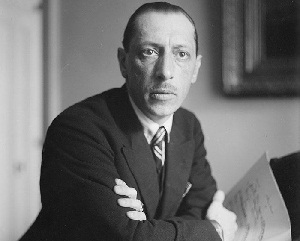 RECENTLY the 70th anniversary of the first visit to Havana by Igor Fyodorovich Stravinsky (1882 –1971) was celebrated, one of the most important and transcendental musicians of the 20th century. On April 6, the 45th anniversary of his death will be commemorated in New York.
RECENTLY the 70th anniversary of the first visit to Havana by Igor Fyodorovich Stravinsky (1882 –1971) was celebrated, one of the most important and transcendental musicians of the 20th century. On April 6, the 45th anniversary of his death will be commemorated in New York.
The exact date of the pianist’s debut on the island (March 3, 1946) was announced in the newspaper El Diario de La Marina. The venue chosen for the performance was the Auditorium Theater on the corner of Calzada and D streets, in Vedado, today the Auditórium Amadeo Roldán.
Stravinsky was the first composer of the modern era in the world and the performance was a real event. His prestige was justified, as he composed a huge number of classical works in various styles, including primitivism, neoclassicism and serialism. However, he is best known worldwide for three pieces at the beginning of his career – known as the Russian period: The Firebird (1910), Petrushka (1911) and The Rite of Spring (1913). For many, these classic, daring and innovative ballets practically reinvented the genre.
In Havana he performed Glinca’s Overture to Ruslan and Ludmila; Tchaikovsky’s Symphony No. 2; The Firebird and selections from the ballet Petrushka.
The musician, speaking to journalist Lisandro Otero, revealed, “I know my music is well known in Havana, and that both ballets have been performed here. I could never have imagined that there was an orchestra of such quality in this city. Although I should have assumed so. I am delighted to conduct my own works with a symphony ensemble of the significance of the Philharmonic Orchestra of Havana.”
Ricardo Villares, in the magazine Bohemia, noted that Stravinsky returned to Cuba and performed on March 4-5, 1951, with a program based on his works Scènes de Ballet, Suites Nos. 1 & 2, Concerto in D Major for String Orchestra and Divertimento.
Meanwhile, Leonardo Depestre Catony reported that he was also here on April 5-6, 1953, when he conducted the Philharmonic Orchestra with selections from Petrushka and Four Norwegian Moods.
MEETING WITH WIFREDO LAM
On his first visit to Havana, Stravinsky met with the great Cuban painter Wifredo Lam and there is an anecdote about the encounter shared by Lam himself, who had been living in Cuba since 1941 with his wife Helena. They lived on Panorama Street in the Havana municipality of Marianao, where they had a small plot of land, a sort of small jungle, which served as the theme for many of his paintings. Inspired by this environment, Lam painted his masterpiece “The Jungle”.
On Sundays the house of the famous artist was filled with luminaries such as Alejo Carpentier, Lezama Lima, Oscar Hurtado, Pepe Rodríguez Feo, Peter Watson, Carlos Steinberg, Pierre Loed and Fernando Ortiz.
In those years, Lam was a regular at concerts in the Auditórium, and his home was often visited by eminent musicians, such as Jascha Heifetz and Igor Stravinsky.
“My house was made of stone,” Lam told researcher Antonio Núñez Jiménez, “and very thick walls, but the roof was in terrible condition. Stravinsky was accompanied by his wife. She had a picture gallery in San Francisco, the U.S. Igor had a head wound, covered with a bandage. The conversation was enlivened with different topics, some strictly personal. My eyes went from Stravinsky’s head to the ceiling, and I thought, ‘If a piece of plaster falls, it will end up breaking this man’s head and they will think it is an attempt on his life.’
“I started to worry about the living room roof, the plaster ceiling was about to collapse. After they left, I went to bed and suddenly heard a loud noise like a truck crash, that made me jump out of bed. The ceiling had dramatically fallen.”
It was after Stravinsky’s visit that Lam painted “The Jungle”, the first visual arts manifesto of the Third World, a fixed idea he brought from his stay in Paris.
But back to Stravinsky, who composed for various types of ensembles in a broad spectrum of classical forms, from operas and symphonies to small pieces for piano and works for jazz groups. He also achieved fame as a pianist and conductor, often of his own compositions.
Essentially a cosmopolitan Russian, he was one of the most influential composers and artists of twentieth century music, both in the West and in his homeland. Time magazine described him as one of the most influential personalities of the twentieth century.